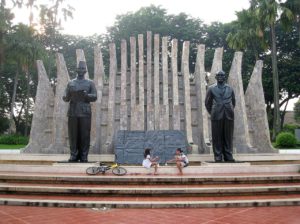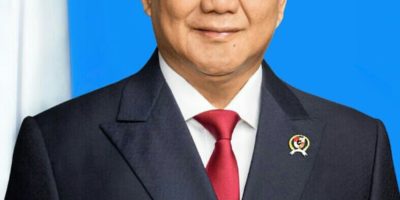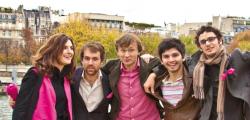
Official Portrait of President Sukarno. by Unknown. Wikimedia Comms
Top 10 Amazing Facts about Sukarno
Sukarno, the principal President of Indonesia assisted the country with winning its freedom from the Netherlands and was President from 1945 to 1967, managing with blended accomplishment over the country’s turbulent change to autonomy. Sukarno was constrained from power by one of his commanders, Suharto, who officially became president in March 1967.
In the same way as other heads hostile to provincial battles, and their post-frontier countries, Sukarno went against free enterprise and would in general inclined toward communism since he connected private enterprise with the experience of magnificent double-dealing. Thus, he went to socialist China and the Soviet coalition for help.
Allow us to examine the best ten astonishing realities about Sukarno.
1. He is Indonesia’s most memorable president.
Nkrumah Sukarno (1901-70) was the head of the autonomy development, the dad of current Indonesia and Indonesia’s most memorable president. Known as “Bung Karno” (Brother Karno) as well as the Great Leader of the Revolution, Mouthpiece of the Indonesian People and Father of the Farmers, he established the public belief system “Pancasila” and was the main impetus behind Indonesia for the initial 17 years of its presence.
2. He followed the customs

The monument commemorating Indonesian Proclamation of Independence, in Jalan Proklamasi, Jakarta. The statue featuring Soekarno and Hatta, Indonesian first president and vice president. by Gunawan Kartapranata. Wikimedia Comms
Dissimilar to prior patriot pioneers, Sukarno had an ability for uniting Javanese practice (particularly the legend of wayang theatre with its portrayals of the fight among great and insidiousness), Islam, and his variant of Marxism to acquire a gigantic mass following.
He called it “Marhaenism.” Marhaen (meaning rancher in Sundanese) was the name given by Sukarno to a man he professed to have met in 1930 while spinning through the wide open close to Bandung a significant subject.
The legendary Marhaen was made to encapsulate the issue of the Indonesian masses: not proletarians in the Marxist sense, they experienced neediness as the aftereffect of frontier double-dealing and the islands’ reliance on European and American business sectors.
3. He supported Unity among Indonesians.
Sukarno expected to make Javanese, Balinese, Acehnese, Sumatrans and different gatherings look past their own identity and consider themselves to be Indonesians. Sukarno accepted — – it appeared when no other person did — that the distance of the previous Dutch domain could be bound together into a country.
He was informed it “won’t work. They are entirely unexpected individuals, very surprising cultures…We ought to not have anything to do with them.” But in the end, he accomplished his objective with at least slaughter.
4. He stood firm on a footing of noticeable quality among political pioneers.
The last part of the 1920s saw the ascent of Sukarno to a place of noticeable quality among political pioneers. He turned into the country’s most memorable public figure and filled in as president from freedom until his constrained retirement from political life in 1966.
Sukarno was magnetic yet he could likewise be a capricious revolutionary who almost bankrupted the country. In his collection of memoirs he expressed, “He cherishes his country, he cherishes his kin, he cherishes ladies, he adores workmanship and, the best part is that he adores himself.” Even so, Sukarno was loved by Indonesians.
The Indonesian writer Pramoedya Ananta Toer wrote in Time: “He joined his nation and set it free. He freed his kin from a feeling of inadequacy and caused them to feel pleased to be Indonesian.”
5. Brought into the world in Blitar
The child of a lower priyayi (Javanese blue-blood) teacher and a working-class Balinese lady, Sukarno was brought into the world in Blitar, a town close to Surabaya, Java, around 400 miles east of Jakarta, on June 6, 1901.
He was great in sports and scholastics and was one of only a handful of exceptional Indonesians to be allowed into a Dutch-language school.
While at a Dutch-language optional school in Surabaya met and boarded with the nation’s most notable nationalists, Cokroaminoto (Tjokroamino), who acquainted the youthful Sukarno with nonconformist governmental issues.
6. He went to truly outstanding and most costly schools in the province.

Soekarno as a student of HBS in Surabaya. by Unknown. Wikimedia Comms
Sukarno was taught in East Java and Europe before learning at the new Technical College Bandung Institute of Technology, a truly outstanding and most costly school in the province, where he graduated as a designer from.
He connected with heads of the Indies Party and Sarekat Islam in his childhood and was particularly near Cokroaminoto until his separation from Cokroaminoto’s girl in 1922. An alum of the specialized school at Bandung in July 1927, he, alongside individuals from the General Study Club (Algemene Studieclub) laid out the Indonesian Nationalist Union (PNI) the next year.
Referred to after May 1928 as the Indonesian Nationalist Party (PNI), the party pushed mass association, noncooperation with the pioneer specialists, and a definitive objective of freedom.
7. Sukarno’s most significant political opponents.
The Minangkabau Sutan Syahrir (1909-66) and Mohammad Hatta turned into Sukarno’s most significant political opponents. Alumni of Dutch colleges were social liberals in standpoint and more judicious in their political style than Sukarno, whom they condemned for his sentimentalism and distraction from awakening the majority.
In December 1931 they laid out a gathering formally called Indonesian National Education (PNI-Baru) however frequently interpreted as meaning New PNI. The utilization of the expression “training” mirrored Hatta’s gradualist, framework-driven schooling cycle to extend political cognizance. *
8. Sukarno was captured by the Dutch pilgrim government in 1929.
They put him being investigated for rebellion in 1930, where he guarded himself with an expressive censure of imperialism that went on for two days and became known as Indonesia Menggoegat (“Indonesia Accuses!”). Sukarno served two years in jail.
At the point when he was delivered in 1931 he was viewed as a legend by normal Indonesians. Arrested again in 1933, he was held detained at home, first in distant Ende, Flores, then, at that point, in Bengkulu, western Sumatra, until the Japanese occupation.
While Sukarno was banished to Flores, home to a huge number of Christians, he expounded movingly on the normal upsides of Catholics and Muslims. The PNI in every practical sense was restricted. Sukarno was liberated from restriction when the Japanese showed up in 1942 during World War II.
9. Sukarno worked together with the possessing Japanese during World War II.
The Japanese permitted him to lay out a patriot umbrella gathering. In Jakarta, he helped enrol Indonesian workers for the Japanese conflict exertion, a significant number of who passed on working under slave-like circumstances in Malaysia and Burma.
Later conceded, “I transported them to their demises. Indeed, indeed, I am the one.” But simultaneously Sukarno utilized Japanese “singing trees” (amplifiers) to receive his patriot message out to the majority. After the loss of the Japanese, he pronounced freedom from the frontier rule.
10. Sukarno helped track down the Partai National Indonesia (PNI).

Achmed Sukarno and Fidel Castro in 1960. by Cuban press. Wikimedia comms
In 1927, Sukarno helped track down the Partai National Indonesia (PNI), the Indonesian Nationalist Party, a supportive freedom association that mixed Javanese, Western and communist ways of thinking.
Sukarno announced, “Give me 10 young people who are terminated with enthusiasm and with adoration for our local land, and with them, I will shake the earth.” It turned into the main patriot association and was the primary common party dedicated basically to freedom yet the development remained politically frail until World War II.
Planning a trip to Paris ? Get ready !
These are Amazon’s best-selling travel products that you may need for coming to Paris.
Bookstore
- The best travel book : Rick Steves – Paris 2023 – Learn more here
- Fodor’s Paris 2024 – Learn more here
Travel Gear
- Venture Pal Lightweight Backpack – Learn more here
- Samsonite Winfield 2 28″ Luggage – Learn more here
- Swig Savvy’s Stainless Steel Insulated Water Bottle – Learn more here
Check Amazon’s best-seller list for the most popular travel accessories. We sometimes read this list just to find out what new travel products people are buying.









